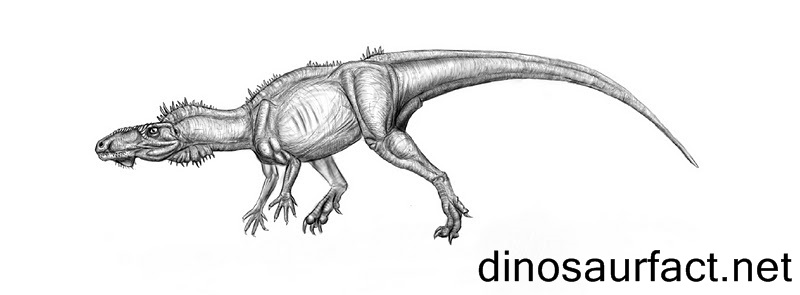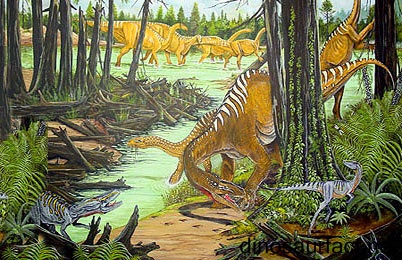 Click to visit the previous dinosaur bio
Click to visit the previous dinosaur bio
 |
|
 |
|
Kingdom: Animalia
Phylum: Chordata
Class: Sauropsida
Superorder: Dinosauria
Order: Saurischia
Suborder: -Not Described-
Family: -Not Described-
Genus: Teyuwasu
 |
|
 |
|
 |
|

The Teyuwasu was a vertebrate animal that walked the earth in the Carnian age of the Triassic period of the Mesozoic era. Very little is known about this creature as only bones of the hind legs are ascribed to it. Some scientists believe it could have been a primitive dinosaur. Others refrain from classifying it any further than a reptilian.
The remains of the Teyuwasu were excavated in Brazil. It could have been in existence about 238 to 225 million years ago.
The Teyuwasu was moderately large in size, as compared to other Carnian vertebrates. Its body structure was very much like crocodilians, except for the longer extremities. It probably walked on all fours, with its center of gravity very close to the ground.
The fossils of the Teyuwasu were considered dinosaurian by scientist Friedrich von Huene. They were later deemed as unclassified, but belonging to a distinct genus, by other paleontologists who examines them. If the Teyuwasu was indeed a dinosaur, it was amongst the earliest one as discovered by man.
Etymology
The word 'teyuwasu' has its origins in the Tupi language of the Tupinamba of Brazil. It is spoken infrequently in Brazil today.
'Teyuwasu' translates to 'large lizard' in Tupi. Although the Teyuwasu was not really a larger dinosaur, its size was bigger than the average modern lizard.
The binomial name Teyuwasu barbarenai was chosen as tribute to the Brazilian scientist Mario Barbarena.
The christening of the remains was done by paleontologist Edio-Ernst Kischlat.
Discovery of fossils
The remains of the Teyuwasu were excavated from the Santa Maria Formation in Rio Grande do Sul in Brazil. They were situated in the Paleorrota Park.
These remains were examined initially by scientist Friedrich von Huene in 1938. They consisted of a femur and a tibia. von Huene had ascribed a few other bones to these fossils. They included the centrum of a vertebra and parts of the pelvic girdle, namely partial pieces of the ischium and pubis. But these were later reckoned unclassified by von Huene himself.
Classification
- Friedrich von Huene determined that the remains attributed today to the Teyuwasu belonged to the Hoplitosaurus on his primary assessment.
The name Hoplitosaurus was already claimed by another scientist for an ankylosaur and hence von Huene changed the generic name to Hoplitosuchus.
- But in the year 1999, paleontologist E. Kinschlat proclaimed that the limb bones did not belong to the Hoplitosuchus. He classified them under a different genus, the Teyuwasu.
- Although Kischlat believed that the Teyuwasu belonged to clade Dinosauria, many scientists oppose this theory today.
Nature of fossils
- Many features on the bones of the Teyuwasu were interpreted differently by different scientists. The direction of the head of the femoral bone was one such issue. Some scientists like von Huene thought it to be naturally so. Others like Ezcurra believed that it had turned in a particular direction due to years of being fossilized. Thus Ezcurra refrained from classifying the remains any further than a dinosauriform.
- The length of the femur of the Teyuwasu is almost the same as its tibia. Although this per say does suggest anything, but it shows that the Teyuwasu could have been a saurischian.
- The head of the femur of the Teyuwasu is small. Also, the distal end of its tibia lacks a crest. Thus scientist Rauhut is if of the opinion that it does not belong to Eusaurischia.
Current location of fossils
The fossils ascribed to the Teyuwasu are preserved at the Ludwig Maximilian's University at Munich.
The Santa Maria Formation and the Paleorrota geopark
- The Santa Maria formation is a natural rock formation located in Brazil. It is made up of sedimentary rocks, because of which it preserved many prehistoric fossils. The remains found in this formation date back to the Ladinian and Carnian ages of the Triassic period. Tetrapod fossils are found abundantly in this formation.
Many vertebrates were discovered in the Santa Maria Formation such as the Chanaresuchus, Belesodon, Spondylosoma, Trucinocynodon, etc.
- The Paleorrota is a natural structure situated in the center of Brazil. Scientists believe that the original span of the Paleorrota extended to present day Africa as well. Africa and South America was then a single super continent Pangaea.
The Paleorrota is divided into seven subdivisions. The Santa Maria Formation is one of them.
The fossils in this structure are chiefly white or reddish brown in color. The ones which are without calcium carbonate are whitish while those rich in calcium carbonate are dark brown in color.
As this structure is very old, the remains found in this region have a wavy appearance due to the pressure of the overlying soil sediments.
Edio-Ernst Kischlat
Edio-Ernst Kischlat is a contemporary Brazilian vertebrate paleontologist. His interests include archosaurs and other primitive tetrapods. He is currently associated with the Federal University of Rio Grande do Sul.
Phenotypic characters
- Based on the thickness and muscle attachments of the femur and tibia, a few physical features of the Teyuwasu can be ascertained.
- It was probably a medium sized dinosaur. Its weight possibly was 40 to 80 kilos. Its length likely was 3 to 4 meters.
- Its head was mostly proportionately tiny as compared to the rest of its body.
- Most scientists concur that the Teyuwasu was a quadruped. It is unclear whether it could support itself on its hind legs.
- The tail of the Teyuwasu was thick and muscular.
Habits and habitats
The feeding and nesting habits of the Teyuwasu are not fully known. This is because its lineage is not clear and its skull bones have not yet been discovered. But it can be inferred that the Teyuwasu was a terrestrial dinosaur.
The habitat of the Teyuwasu was rich in rivers, ponds and other water sources. Such an environment was conducive for both carnivorous and herbivorous organisms.
Related and coexisting species
The Teyuwasu showed many aetosaurian features and is believed to be related to the Hoplitosuchus. It may also have been related to primitive theropod dinosaurs such as the Herrerasaurus. Some scientists presume the Teyuwasu to be related to basal sauropods.
It could have shared its habitat with the Eorapter, Guaibasaurus, Herrerasaurus, Pisanosaurus, Saturnalia, etc.
Epilogue
The Teyuwasu may or may not have been a dinosaur. But its discovery has helped paleontologists better evaluate the rich variety of the fauna of the middle Triassic period.
Index
Extinct Profiles
 Triassic Dinosaurs
Triassic Dinosaurs Jurassic Dinosaurs
Jurassic Dinosaurs Cretaceous Dinosaurs
Cretaceous Dinosaurs Pterosaurs
Pterosaurs Marine Reptiles
Marine Reptiles Dinosaur Extinction
Dinosaur Extinction